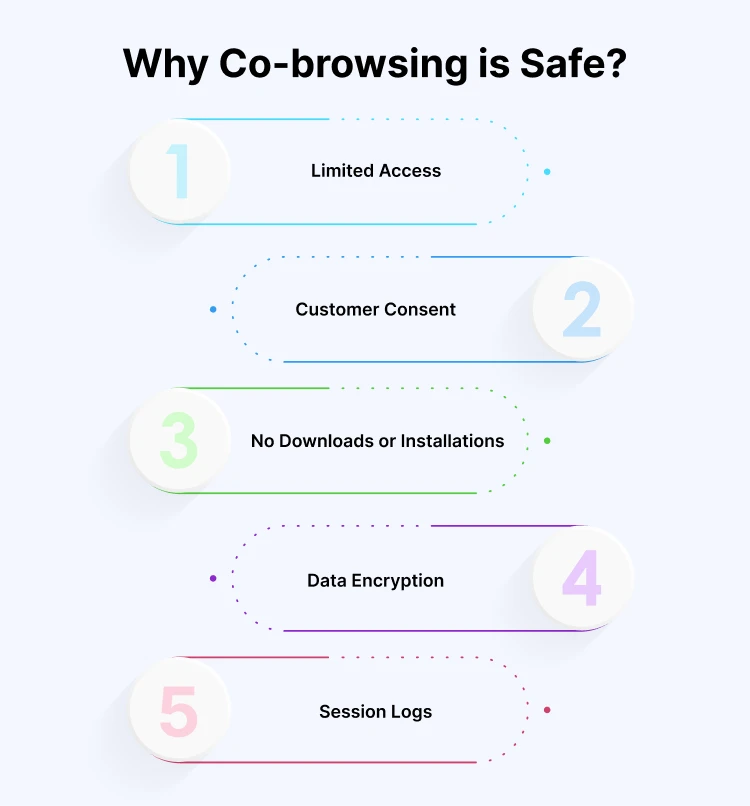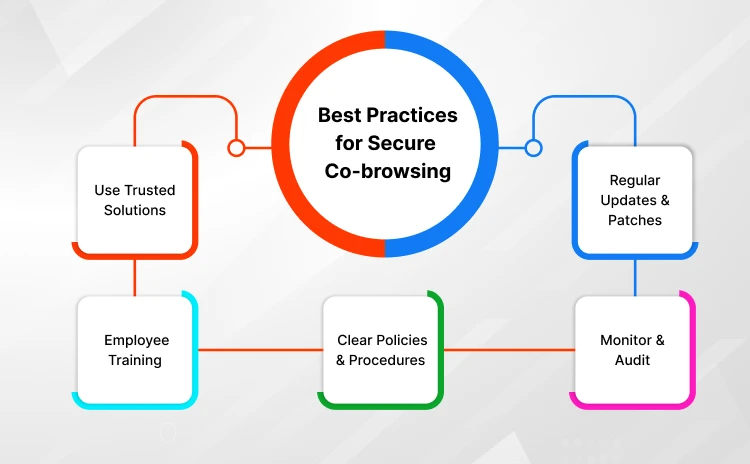Is Co-browsing Safe? Best Practices & Security Insights
- August 12, 2024
- 8 mins read
- Listen

Table of Content
Consumers are often warned to be wary of cyber-crime and to be mindful of their online security. This can be intimidating for those unfamiliar with the co-browsing technology, making them feel exposed and vulnerable.
In this blog, we’ll explore how co-browsing is safe and differs from screen sharing & security measures that protect your data. Understanding these aspects will help you see, why co-browsing is a safe and effective tool for customer support. Let’s begin.
What is Co-browsing?
Co-browsing is a form of collaborative browsing. It is a navigation on the web made by both parties (Agent & Client) to provide real-time customer support. When a customer struggles to find something on your website, an agent can use co-browsing to assist instantly and provide the best customer experience.
This kind of functionality has been widely adopted in customer service for both B2C and B2B interactions. According to a Forrester survey, co-browsing achieved a 78% customer satisfaction rate, compared to 24% for email support and 9% for online chat.
Why Co-browsing is Safe?
Co-browsing is safe because it only functions on pages where the necessary code is implemented. If the code isn’t present, co-browsing won’t operate on that page. Let’s see why co-browsing is a secure solution for modern customer support needs.
1. Limited Access
Co-browsing sessions are restricted to a single browser tab, which means the agent cannot see the customer’s entire screen or access unrelated information. For instance, if your customer having trouble completing a transaction on an e-commerce site, the agent can only view and interact with that specific tab & ensures that the customer’s email, social media, and other open tabs remain private.
2. Customer Consent
Before a co-browsing session can begin, it requires the customer’s explicit consent. This ensures that customers are fully aware of and agree to the interaction. For example, when a customer contacts your support team for help, they receive a prompt asking for permission to start a co-browsing session. Only after they click ‘Yes’ does the session start, ensuring transparency and control.
3. No Downloads or Installations
You don’t need to download or install additional software to operate co-browsing directly within the web browser. This reduces potential security risks associated with installing unknown software. For example, a customer using an online banking service can get immediate help with their account without needing to install any extra programs, which keeps their device safe from potential malware.
4. Data Encryption
Modern co-browsing solutions use advanced GDPR (General Data Protection Regulation) to protect data transmitted during the session. This ensures that sensitive information remains secure. For example, when a customer shares their screen to resolve an issue with a financial transaction, the data exchanged between the customer and the agent is encrypted, preventing unauthorized access.
5. Session Logs
Many co-browsing tools maintain detailed logs of the sessions and provide a record that is reviewed for security and compliance purposes. For example, if there is a need to review the interaction, session logs are accessed to verify what actions are taken. It ensures that all procedures are followed correctly.
Co-browsing Vs. Screen Sharing: a Security Perspective
When it comes to customer support, both co-browsing and screen sharing are valuable tools. However, co-browsing stands out as the safer option compared to traditional screen-sharing technologies. To help you better grasp the distinctions between these two tools, here’s a table highlighting their key differences:
|
Capability |
Co-browsing |
Screen-sharing |
|
Scope of Access |
Access is limited to a single browser tab. |
Full access to the entire desktop. |
|
User Control |
Customers retain control and can end the session anytime. |
The agent often has more control over the customer’s desktop. |
|
Ease of Use |
No additional software is needed, operates within the web browser. |
Often requires downloading and installing software. |
|
Security |
Masking of sensitive data |
No masking available |
|
Type of sharing |
Code-based |
Video-based |
|
Agent tools |
highlighting, annotation, drawing |
Limited |
|
Scrolling, clicking, typing |
Agent and customer can interact with the page at the same time |
Only one party can access at the same time |
|
Session takeover |
users can change agency over the session |
Users can not change agency over the session |
Best Practices for Secure Co-browsing
Data security is pivotal in this competitive business world. To maximize the security of co-browsing sessions, you should implement the following best practices:
1. Use Trusted Solutions
Select reputable co-browsing providers. Opt for solutions from providers known for their commitment to security and a proven track record of safeguarding user data. For example, well-established companies like REVE Chat, prioritize safety and meet all data and security regulations. It is ISO 27001 and PCI DSS validated.
2. Regular Updates & Patches
Ensure that the co-browsing software is regularly updated to address any security vulnerabilities. Just as with any other software, co-browsing solutions need frequent updates to patch potential security gaps. For example, a financial institution might schedule routine checks and updates of its co-browsing tools to protect sensitive customer information.
3. Employee Training
Train your customer support agents on the importance of security and privacy during co-browsing sessions. Comprehensive training programs can equip agents with the knowledge to handle sessions securely, recognize potential threats, and respond appropriately. For example, regular workshops on best practices for secure interactions can enhance the overall security posture.
4. Clear Policies & Procedures
Establish and enforce clear policies regarding the use of co-browsing, including guidelines for obtaining customer consent and handling sensitive information. These policies should clearly define what is acceptable during a co-browsing session. It also ensures that customers are fully informed and given explicit consent before starting. For example, a policy might mandate that agents explain the co-browsing process and obtain verbal consent before initiating a session.
5. Monitor & Audit
Regularly monitor and audit co-browsing sessions to detect and address any potential security issues promptly. Implement a system to log and review sessions. It can help identify unusual activities or breaches. For instance, periodic audits of session logs could reveal patterns that suggest security weaknesses and allow for timely interventions.
Role of Co-browsing in Diverse Industries
Co-browsing solutions offer myriad benefits across various industries. It addresses specific pain points and enhances customer support experiences. Below are a few of the sectors that leverage co-browsing to overcome challenges:
E-commerce: Reduce Cart Abandonment
Online retailers often struggle with high cart abandonment rates and customer confusion during the checkout. Support agents can guide customers in real-time through the website, help them locate products, understand features, and complete transactions using a co-browsing solution.
Secure co-browsing ensures that sensitive information, such as payment details, remains protected through advanced encryption and limited access.
Financial Services: Solve Complex Transaction Challenges
Banks and financial institutions face the challenge of assisting clients with complex transactions and account management while maintaining stringent security standards. Co-browsing allows support agents to help customers navigate online banking portals, fill out forms, and complete transactions securely.
Co-browsing restricts the session to a single browser tab and uses data masking, ensuring that sensitive financial data is not exposed.
Insurance: Streamline Complex Policy Explanations
Insurance companies often deal with complex policy explanations, claims processing, and form submissions. It makes customers confused and creates frustrations Agent can use co-browsing tools to assist customers through policy details, help with claims submissions, and clarify any doubts directly on the web page.
This reduces the chances of errors and increases customer satisfaction. Co-browsing ensures that sensitive personal and financial information is protected through advanced encryption and limited session access.
Tech Support: Simplifying Troubleshooting Issues
Tech support teams frequently handle complex software installation issues that can be difficult for customers to manage alone. Agents can enable co-browsing to guide customers through these processes in real-time, directly on their browser.
It reduces resolution times and enhances customer satisfaction. Secure co-browsing ensures that only the relevant browser tab is accessible to the agent, protecting the customer’s other data and applications from exposure.
REVE Chat’s Co-browsing for Effective Customer Support
With REVE Chat co-browsing solution you can deliver a collaborative customer experience with personalized interaction.
REVE Chat has robust security features and a user-friendly design that helps businesses deliver more secure and hassle-free customer support. As an ISO-certified platform, it ensures that all interactions meet the highest standards of quality and security.
Additionally, this platform adheres to GDPR data policy to protect customer information. With its Co-browsing solution, you can provide real-time assistance, transform customer service experiences, and build trust with every interaction.
Conclusion
Co-browsing allows you to surpass today’s customer expectations. By integrating personalized communication with visual engagement tools in a video chat, you’ll create a collaborative experience that significantly enhances customer satisfaction.
Simply put, there is nothing to worry about using a co-browsing solution. You can rely on trusted and specialized companies in the industry. Ready to enhance your customer support with secure co-browsing? Request a product demo now.





